The first document attesting to the relationship between the great painter Lorenzo Lotto (Venice, 1480 - Loreto, 1557) and the town of Jesi, a center where no less than five important Lotto masterpieces are preserved, is a contract dated October 27, 1511: on that date, the artist undertook to execute, for the confraternity of the Good Jesus, an altarpiece that had been entrusted in 1508 to Luca Signorelli (Cortona, 1445/1450 - 1523) and which was intended for the confraternity’s chapel in the church of San Floriano. At the time, Jesi was one of the most important cities in the Marca d’Ancona, a sort of province of the Papal States.Lorenzo Lotto had visited the Marca for the first time in June 1506, staying in Recanati. It was a prosperous territory, whose economy was based on agriculture on the one hand and on the other on flourishing international trade (which had fundamental junctions in the port of Ancona and in the fairs of Fermo and Recanati: the latter, in particular, was the busiest in the whole Papal State), which enjoyed a certain autonomy from Rome (the cities not infrequently had their own statutes), and whose religious centers, in particular the sanctuary of Loreto, were of further economic importance. We do not know quite how Lorenzo Lotto came into contact with the Marche, he who in 1506 was active in Treviso: however, since Recanati was one of the most significant commercial hubs in central Italy and since many Venetians traded in the area, it is likely that the link matured in this context. It is entirely probable that Lorenzo Lotto was greatly enticed by the fee that the Recanati Dominicans offered him for the polyptych to be installed in the local church of San Domenico (now preserved in the Civic Museums of Villa Colloredo Mels): 700 florins, a very high sum, especially if we consider that it corresponds to seven times the pay that Luca Signorelli was granted the year before for the Deposition of Matelica. A figure that attests to the wealth of the city that was preparing to host the Venetian painter.
Lotto initially thought he would not stay long, since, having returned to Treviso for some time in the fall of 1506, he made an agreement with the landlord of his home that he would keep the house free for when he returned once he had finished his work in the Marche. We know, however, that things turned out differently and that Lorenzo Lotto had a very deep relationship with Le Marche, so much so that he returned there for three more sojourns, and the last was the final one, since the artist died in Loreto in 1557. The second of the four sojourns, which began in 1509 and was still spent in Recanati, was the one in which Lorenzo Lotto was first hired for a work in Jesi: we do not know whether on that occasion the artist actually went to the city or whether he executed the work in Recanati, and there is also little information on the circumstances that led the Confraternity of the Good Jesus to entrust him with the Deposition. We do know that he and Signorelli knew each other in person (in 1510 the Venetian artist had been in Rome, on the site of the Vatican Stanze: it was there that he met the Cortonese), and it is possible that it was Signorelli himself who pointed out Lorenzo Lotto after he turned down the work, probably because he could not take on the work he had been assigned (although we do not know for sure).
The commission therefore fell to Lorenzo Lotto, who in a few months completed his centered altarpiece, almost three meters high, and divided into two distinctly separate registers: at the top the hilly landscape, with on the right the Golgotha on which the three crosses stand out (the one of Jesus with the ladders leaning, the others with the two thieves still hanging), and on the left the slopes sloping toward the horizon. Below is the scene of the deposition of Christ, who is lowered into the marble tomb, placed diagonally, by means of a sheet supported with difficulty by Nicodemus and Joseph of Arimathea (Nicodemus helps himself by holding a flap between his teeth: Lorenzo Lotto’s inventions always reveal bizarre and unexpected details), while all around is palpable the despair of the Madonna raising her arms to heaven, of St. John behind her repeating the usual gesture, and of Magdalene on the opposite side of the tomb, who for the last time caresses Christ’s hand. The composition has obvious debts to the Deposition that Raphael painted just five years earlier for Atalanta Baglioni (today the work is in the Galleria Borghese): the idea of Christ’s body suspended on the sheet, the right arm descending vertically, the fatigue of those holding it, and the landscape with crosses in the upper right-hand corner are all borrowed from the painting that Urbino executed for the noble family of Perugia. So much so that, in one of his recent essays, Alessandro Delpriori defined the Jesi Deposition as “a manifesto of the most observant Raphaelism, starting with the opening of the landscape behind the sacred group,” and with the “concitement of the figures and their expressive rhythm” that are configured as elements “fully Raphaelesque with inserts of ’terribleness’ in the musculatures, in the coruscating faces that presuppose the Sistine vault.”
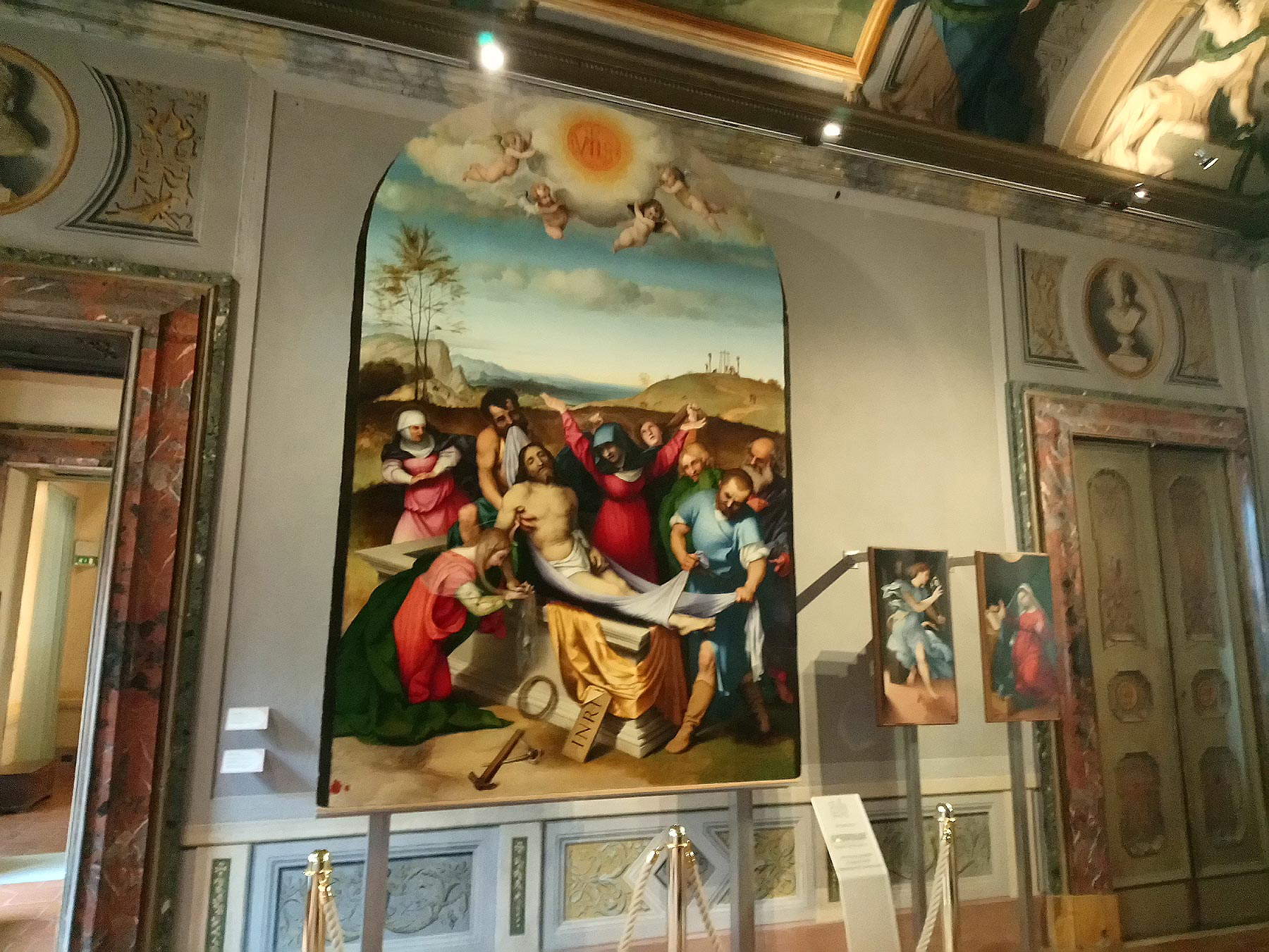 |
| Lorenzo Lotto at the Pinacoteca Comunale di Jesi. Ph. Credit Finestre Sull’Arte |
 |
| Lorenzo Lotto at the Pinacoteca Comunale di Jesi. Ph. Credit Finestre Sull’Arte |
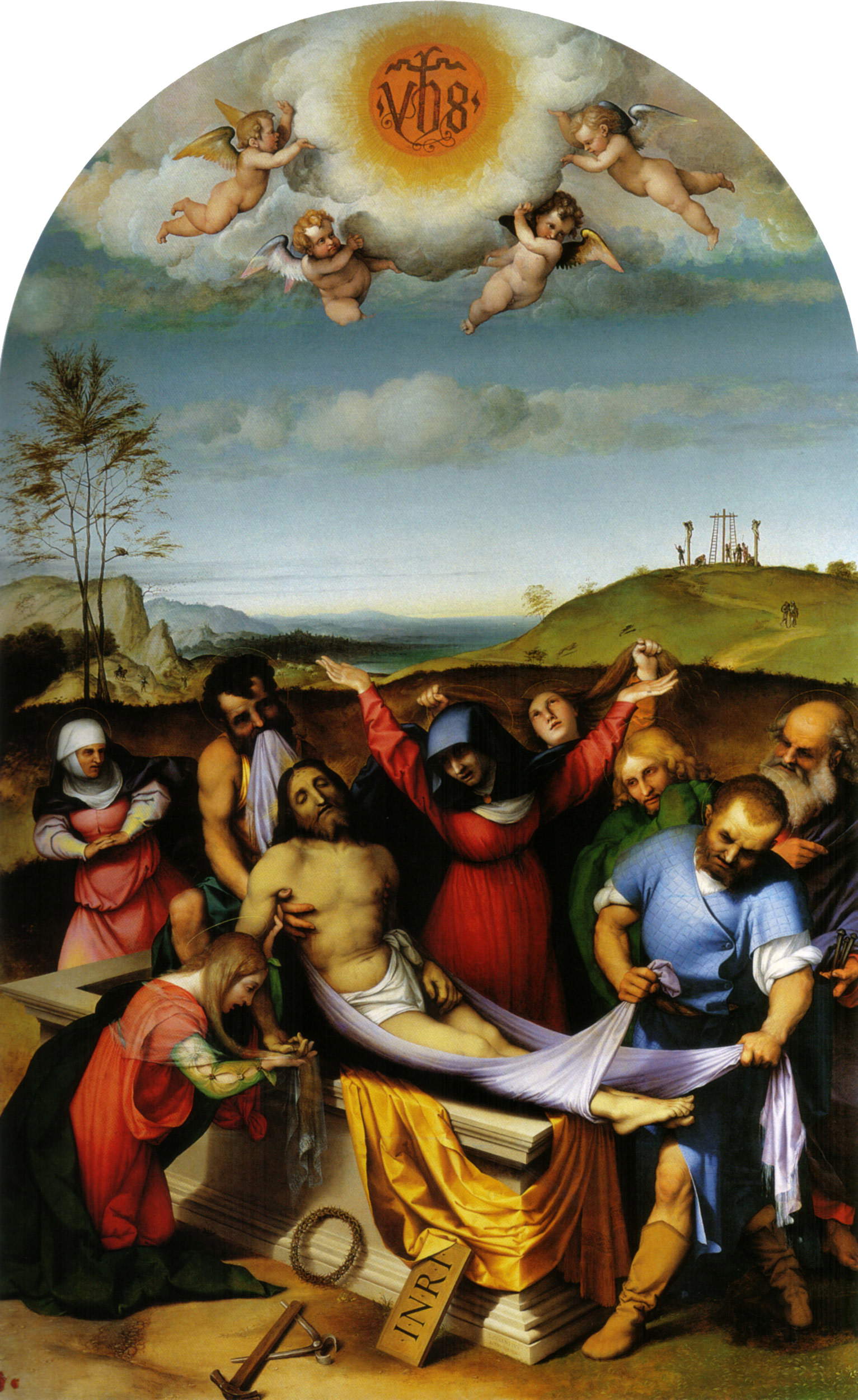 |
| Lorenzo Lotto, Deposition (1512; oil on panel, 298 x 198 cm; Jesi, Pinacoteca Comunale, Palazzo Pianetti) |
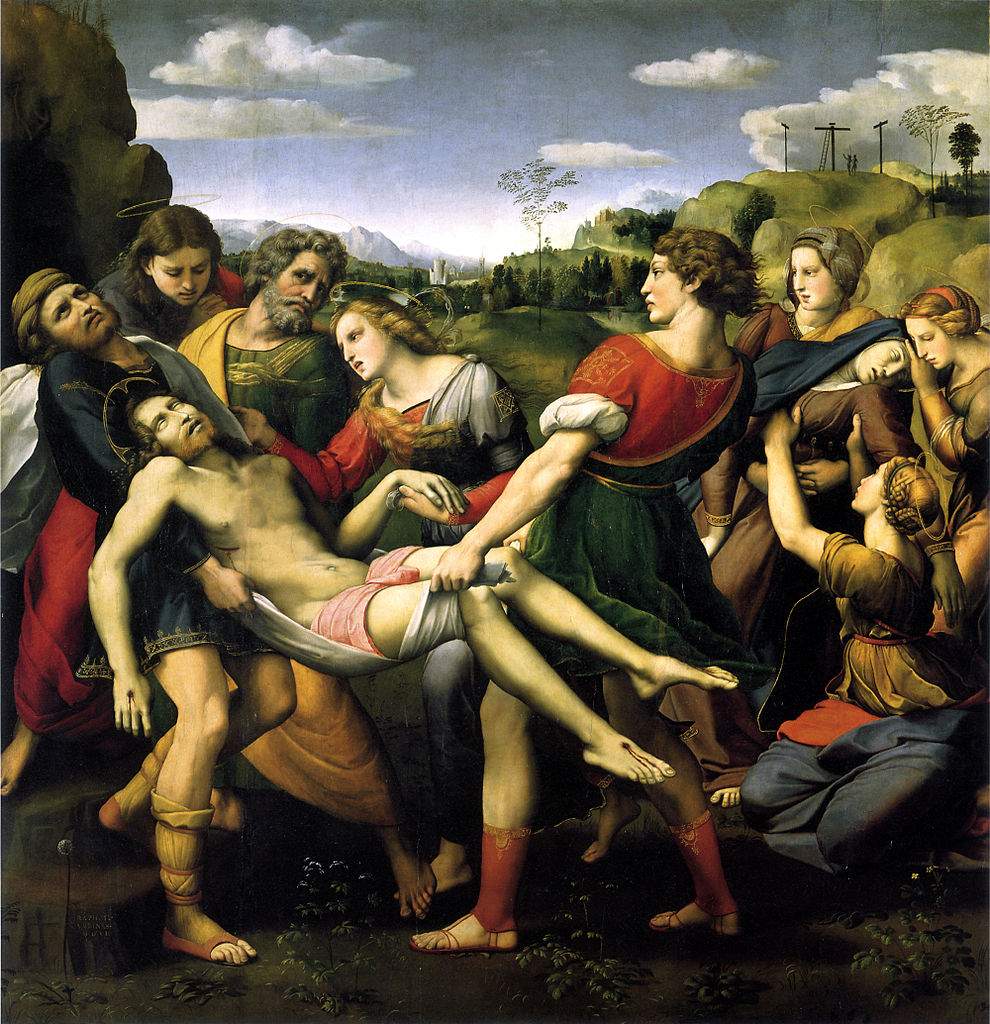 |
| Raphael, Borghese Deposition (1507; oil on panel, 174.5 x 178.5; Rome, Galleria Borghese) |
For the work, Lorenzo Lotto obtained a fee of 125 ducats, 25 more than what had originally been agreed to Luca Signorelli (whose contract, however, also included board and lodging in Jesi, whereas the document signed by Lorenzo Lotto lacks this condition, and the expenses were therefore his responsibility): the artist quickly honored the commission, since the painting, as early as 1512, was able to be installed in the church of San Floriano (today, however, like all the paintings Lotto executed for Jesi, it is kept in the Pinacoteca Comunale of the Marche city, where it was transferred in 1949, first to the premises of Palazzo della Signoria and then to those of Palazzo Pianetti). It is a painting of great importance in the career of the Venetian artist because, along with other works of the period (such as the imposing Transfiguration of Recanati, circa 1511), it marks his closest approach to Raphael, just a few months after his return from Rome, where Lotto was evidently impressed by the works of the Urbino: art historian Pietro Zampetti, a great exegete of Lorenzo Lotto, says that, with the Deposition, the Venetian abandons all fifteenth-century heritage to embrace the new century in all respects. Moreover, the painting’s strong emotional rendering (the weeping of Magdalene, the gazes of Nicodemus and Joseph of Arimathea, the despair of the Virgin and St. John) have led some scholars to establish relations with the Tuscan manner of artists such as Sodoma and Domenico Beccafumi, who were also active in Rome at the time Lorenzo Lotto visited the capital of the Church State.
A few years elapsed before the artist returned to work for Jesi, but relations then thickened: on December 11, 1523, Lorenzo Lotto is witnessed in the city, where a contract was made with the confraternity of Santa Lucia for the painting of the sodality’s altarpiece, also destined for the church of San Floriano, for a fee of 220 ducats. In all likelihood, facilitating the artist’s contacts with Jesi was Balsarino Marchetti, a merchant from Bergamo (Lotto, in the 1920s, was in fact residing in Bergamo), who had interests in Jesi, and in the city of the Marca he also owned a house: Marchetti also played the role of the artist’s procurator in the bureaucratic paperwork connected with the new work for the church of San Floriano, and it is interesting to note how, moreover, Lorenzo Lotto got to know the merchant, hypothesizes scholar Francesca Coltrinari, at the Recanati fair, during his first stay in the Marche region. The work, however, took a long time (the St. Lucy Altarpiece would not be delivered to the confreres until 1532, as attested by the date the painter affixed to the work, when delivery had been agreed for 1525), and in the meantime the artist attended to other works. One of these is the triptych (or perhaps the polyptych) from which come the two panels with the AnnouncingAngel and the Virgin Announced that constitute two pinnacles of Lotto’s production. The archangel Gabriel is caught in flight, wearing a robe of a soft iridescent blue, with short sleeves, and tied at the waist with a single pale yellow belt, which flutters in all directions: the divine creature strides with his left leg, the right is bent, and the torso is twisted, with the result that the face is turned in profile (the brown hair, highlighted with blond, is also moved by the wind). With his left arm drawn back he holds up a lily, holding it gently with thumb and forefinger, while his right is bent and facing Mary to greet her. She is as if suddenly distracted from the reading: we can imagine her being suddenly interrupted and leaping backwards with a jerk, removing her left leg from the kneeler and balancing precariously on her right, as she brings her arms back showing her palms in astonishment, and revealing an expression that manifests both awe and surprise. The heavy blue cloak falls and leaves the entire red robe folded at breast height uncovered, and the white veil revealing a brown hair, combed with a parting in the center.
About these two panels, placed by critics at about 1526, the great art historian Bernard Berenson wrote that here “Lotto’s humanity becomes deeper and more refined.” this is because the vitality that emanates from this intense painting, which captures a moment and denotes great participation on the part of the artist, a participation that is perhaps also emotional (an element, this, that is after all in line with a large part of Lorenzo Lotto’s production), shows that the artist meditated on the text of Luke’s Gospel, trying to render the story in an empathetic way, and in this way producing one of the most vivid, most original (the novelty of the angel suspended in flight and caught an instant before touching the ground is one of the artist’s many inventions) and most recognizable images of theAnnunciation in the entire sixteenth century. With these panels, emphasized the great art historian Anna Banti, “we see inaugurated a formula of compromise that becomes evasion: happy evasion from the corollaries of a knowledge now acquired and pondered on the possibility of interpreting aspects by incidence of light ray and only by that.” As for the current state of the two panels, as mentioned they are what remains to us of an earlier polyptych: the discovery of a drawing in the 1960s has led scholars to speculate that theAnnunciation panels are what remains of the San Giovanni Altarpiece, that is, a work that, it is speculated, Lorenzo Lotto made in the 1920s. In all likelihood, the two panels are the side compartments of a machine that had at its center a Vision of St. John in Patmos, which was lost as a result of Napoleonic requisitions (until earlier, in fact, sources attest that the St. John Altarpiece could be seen, intact, in the church of San Floriano). We do not know what happened to the central compartment: the panels with the angel and the Virgin, however, were found in 1832 in the convent of San Floriano, and then in the twentieth century transferred first to the Municipal Library of Jesi (where Berenson saw them in 1955) and then to the Pinacoteca. The work was probably commissioned by the Ghislieri family of Jesi: some of its members had relations with Lotto as part of the commissions for the Deposition and the Santa Lucia Altarpiece.
 |
| Lorenzo Lotto, Announcing Angel and Virgin Announced (c. 1526; oil on panel, 82 x 42 cm; Jesi, Pinacoteca Comunale, Palazzo Pianetti) |
To the same period as theAnnunciation dates the Madonna of Roses, so called because of the detail of rose petals scattered on the ground (a probable reminder of the rites in honor of the Madonna during which it was indeed customary to scatter rose petals), which we observe at the foot of the throne on which the Virgin and Child sit: it is a sacred conversation, and we see the two protagonists flanked by Saints Joseph and Jerome, while the cymatium depicts Saint Francis, caught in the act of receiving the stigmata, and Saint Clare. This extraordinary painting strikes the viewer because it is one of the most balanced of Lorenzo Lotto’s production: the figures take on monumental proportions, occupying their positions according to an almost geometric arrangement, which is not interrupted even by the detail of the Child waving in the direction of the putative father who, with a gesture of affection, turns his palms toward him as if to receive him from his wife (the diagonal is balanced, on the opposite side, by the left arm of the Virgin who, with two fingers, touches the book of St. Jerome, encased in his ample cardinal’s robe, which seems almost a few sizes larger, and leaning toward the Virgin, after having removed his headdress and nonchalantly resting it on the base of the throne (the cord has remained on the plinth’s support surface). Balance is also rendered at the chromatic level, since the entire composition is based on the primary colors (the yellow of St. Joseph, the blue of the Virgin, and the red of St. Jerome). All this is covered by a large green curtain that, like a curtain, rises on one side and allows a glimpse, behind St. Joseph, of a rose garden that, like the petals in the foreground, alludes to Our Lady (the rose, a symbol of love and virginity, is a Marian attribute par excellence and recalls the mystical rose of the ancient litanies).
Note the variety of rose chosen by Lorenzo Lotto, namely the white centifolia with red tips, thus symbolizing on the one hand the purity of the Virgin and on the other the drops of the blood shed by Jesus on the cross. The Madonna of Roses is in fact a work pregnant with symbolic references that are also evident from the studied gestures, as Marina Massa noted in the catalog of the exhibition Lorenzo Lotto. The Call of the Marches, held in Macerata in 2018: “to an emotional and involving participation seems to allude, in a virtuous circuit of affections, the exedra arrangement of the figures and the light that from the rose garden slips on the compact silhouette of St. Joseph, to thicken on the folds of the Virgin’s dress and reflect on St. Jerome, whose melancholic expression, full of ominous omens, it emphasizes. The same ones that are enclosed in the book of the Holy Scriptures that he holds in his hands and which, with a firm gesture, Our Lady imposes remains closed, turning instead to the Child who, still unaware, expresses in full all his lively and childlike vitality.”
Further symbolic references are those that link the two portions of the altarpiece, the “diurnal” portion of the lower register, and the “nocturnal” and dense with mysticism portion of the lunette with St. Francis and St. Clare: the sense of Jesus’ sacrifice is thus reflected in St. Francis reliving the crucifixion by receiving the stigmata and in St. Clare holding in her hands a monstrance with the consecrated host. The two saints in the lunette give us a glimpse of the milieu within which the work was born: the Madonna of Roses was intended for the church of San Francesco al Monte in Jesi (and for this reason it is also known as the San Francesco al Monte Altarpiece), and Lorenzo Lotto executed it on commission from the Order of the Friars Minor Observant, who at the time were renovating their church in Jesi built in the 15th century and who, on the basis of documents that have come down to us, we assume must have been the direct commissioners of the painting. The altarpiece left the house of worship in 1866, since in that year San Francesco al Monte was closed to worship and its works destined to replenish the first nucleus of the nascent Pinacoteca Civica. The work is signed and dated (“LAURENTIUS LOTUS MDXXVI”), suggesting that the artist must have received the commission during his second visit to Jesi in the 1920s, which occurred in April 1525 in order to collect part of the payments for the Santa Lucia Altarpiece.
| <img src=’https://cdn.finestresullarte.info/rivista/immagini/2020/1282/lorenzo-lotto-madonna-rose.jpg ’ alt=“Lorenzo Lotto, Madonna of Roses (1526; oil on panel, 155 x 160 cm; Jesi, Pinacoteca Comunale, Palazzo Pianetti) and <a href=”https://www.finestresullarte.info/art-base/lorenzo-lotto-life-work-painter-quiet“>Lorenzo Lotto</a>, St. Francis Receiving the Stigmata and St. Clare (1526; oil on panel, 155 x 160 cm; Jesi, Pinacoteca Comunale, Palazzo Pianetti) ” title=“Lorenzo Lotto, Madonna of Roses (1526; oil on panel, 155 x 160 cm; Jesi, Pinacoteca Comunale, Palazzo Pianetti) and Lorenzo Lotto, Saint Francis Receiving the Stigmata and Saint Clare (1526; oil on panel, 155 x 160 cm; Jesi, Pinacoteca Comunale, Palazzo Pianetti) ” /> |
| Lorenzo Lotto, Madonna of Roses (1526; oil on panel, 155 x 160 cm; Jesi, Pinacoteca Comunale, Palazzo Pianetti) and Lorenzo Lotto, Saint Francis Receiving the Stigmata and Saint Clare (1526; oil on panel, 155 x 160 cm; Jesi, Pinacoteca Comunale, Palazzo Pianetti) |
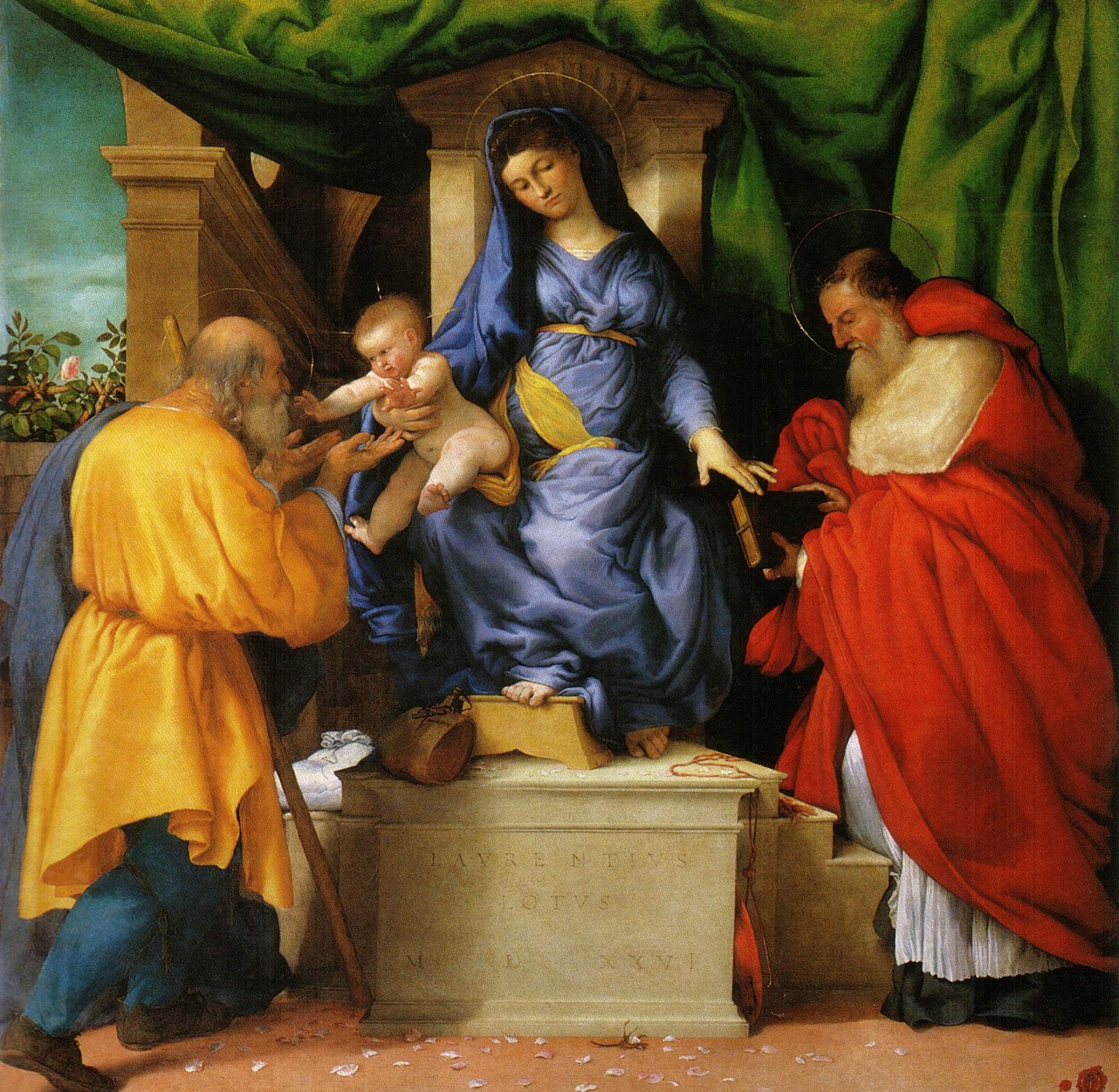 |
| Lorenzo Lotto, Madonna of the Roses, detail |
Following these trials, the relationship between Lorenzo Lotto and Jesi is again documented in the 1930s, at the time of the completion of the Santa Lucia Altarpiece. As anticipated, the contract of lodgement is dated December 11, 1523, the day on which the painter was in town to sign the contract in the presence of the notary Orsino Orsini: the document stipulated delivery for 1525 (the work would be sent to Jesi by sea, leaving from Venice: the 220 ducats agreed upon also included the cost of transportation, which the artist would bear). Things took a long time, however, probably because the confraternity was unable to pay the bill to the artist (so much so that, in 1528, it was thought to entrust the painting to another painter, Giuliano Presutti from Fano), and in 1530 the situation was still at a standstill: it was all resolved the following year, when one of the members of the sodality, Apollonio Buonafede, proposed selling a house owned by the confraternity (worth 130 florins) to obtain the amount with which to pay Lorenzo Lotto. The stratagem thus enabled payment for the work, which was finished in 1532, as evidenced by the painter’s signature.
The altarpiece dedicated to the patron saint of the confraternity (an imposing painting two and a half meters high, after the Deposition the largest of those painted for Jesi) depicts a scene with St. Lucy before the judge, but to place it in the context of the martyr’s story it is necessary to make the reading begin with the first scene of the predella, where we see St. Lucy visiting the shrine dedicated to St. Agatha: the future saint, who lived at the time of the persecutions against Christians under Emperor Diocletian, had gone there with her mother Eutychia, who suffered from hemorrhage, in order to ask for the intercession of the Catanian martyr to heal the elderly woman. In return, Lucia would vow herself to God, after donating her wealth to the poor (we see her intent on this activity in the right-hand side of the first scene). Eutychia healed, and Lucia thus began her journey to help the needy, causing, however, the wrath of her fiancé, who saw the girl’s coveted dowry vanishing, and therefore decided to denounce her as a Christian. Lucia therefore went to trial, and Judge Paschasius (we meet him in the right side of the second panel of the predella) questioned her, accusing her of worshiping the Christian God. The reading thus shifts to the large panel, through the bizarre device of the curtain that interrupts the second panel of the predella and suggests we look up: here, Paschasius passes his sentence, and the thugs seize Lucia to lead her to her torture. The torment begins in the second scene of the predella: oxen try to lead her to the torture, but according to legend God made Lucia’s body so heavy that the animals could not move her an inch. The third scene of the predella is a continuation of the second: against the backdrop of a city, pairs of oxen follow one another, unable to move the very young saint (according to tradition she was just 21 at the time of her martyrdom). At the beginning of the 20th century, an anonymous artist added an addition to the predella to conclude the narrative, depicting the martyrdom of St. Lucy at the stake: today it is displayed in the same room, obviously detached from the rest of Lorenzo Lotto’s work.
The scene takes place under a portico, identified as one of the loggias of the Palazzo della Signoria in Jesi: the judge, seated on a high throne foreshortened diagonally, reminding us of Titian’s Pala Pesaro, delivers his verdict, and the figure of Saint Lucy, firm and resolute in her faith, serves as his visual and moral counterpart. Her steadfastness is well exemplified by her pose, the gesture of her index finger pointing upward, and the nonchalance she demonstrates as the crowd around her comments on the scene, and probably judges her exactly as Pascasius is doing, and the torturers try to drag her away. The whole construction of the composition is aimed at converging precisely toward the saint, as suggested by the diagonals: that of the wing of the crowd, that of Pascasius’ wand, and finally the tender detail of the child who tries to reach the saint but is held back by the fantesca. It is a scheme that recovers ideas already addressed in the wooden inlays the artist made for the choir of Santa Maria Maggiore in Bergamo (a coeval work): the perspective cut, the background with elements of contemporary cities, the wings of the crowd attending the scene with the characters also in 16th-century clothing. And everything is aimed at exalting, as mentioned, the resolve of the saint: Massimo Firpo, in one of his 2001 books devoted precisely to the “world of Lorenzo Lotto,” wrote that “it is precisely the proclamation of the unwaveringness of faith and its salvific value that take center stage in the altarpiece,” suggesting that the artist, in having painted the character behind Saint Lucy looking at the viewer with the same identical face of the St. Paul of the Ponteranica Polyptych (a work painted in 1522), perhaps wished to allude to “the centrality of the debate ’about the Pauline letters and the role of faith for the purposes of salvation that then invaded the churches and squares of Italian cities.’” The theological value of this painting has also been well emphasized by scholar Marta Paraventi, who calls it “emblematic of Lotto’s ability to delve into hagiographic texts in order to investigate them and restore them in iconographic terms,” and in this sense the artist, with the St. Lucy Altarpiece, “is free to create a new narrative scheme where St. Lucy becomes, in the wake of Erasmian ideas, a real model of life for the true Christian.”
 |
| Lorenzo Lotto, St. Lucy Altarpiece (1532; oil on panel, 243 x 237 cm, the predella oil on panel 32 x 69 cm each; Jesi, Pinacoteca Comunale, Palazzo Pianetti) |
 |
| Tiziano Vecellio, Pala Pesaro (1519-1526; oil on canvas, 478 x 268 cm; Venice, Basilica di Santa Maria Gloriosa dei Frari) |
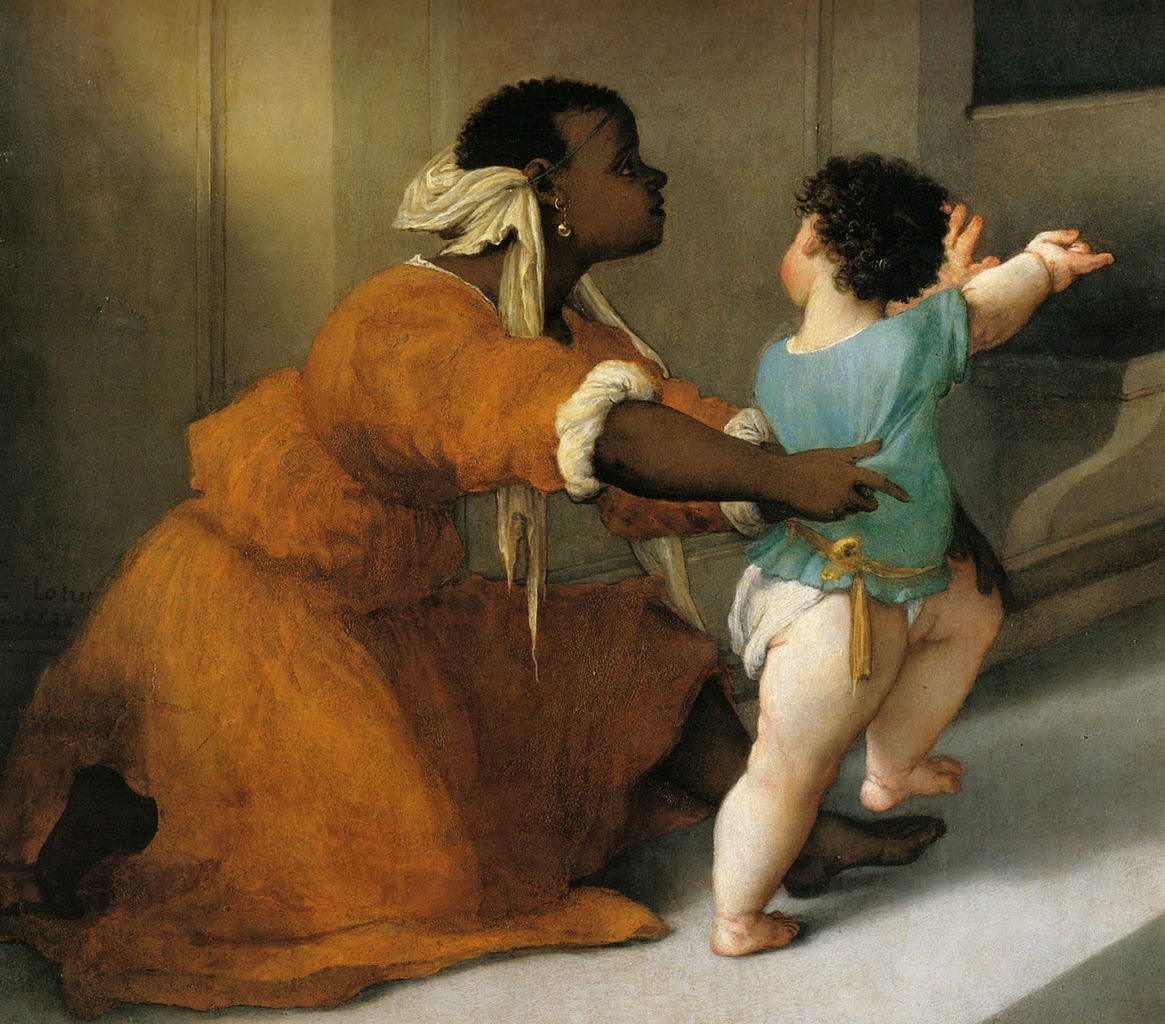 |
| Lorenzo Lotto, Altarpiece of Santa Lucia, detail |
Lorenzo Lotto returned one last time to Jesi in 1535, having arrived in the city “ad far la capella de li signori del palazo”: on July 1 of that year, in fact, the Council of Credenza of the Municipality of Jesi commissioned him to paint an altarpiece for the chapel of the priors of the Palazzo della Signoria, which, however, was never realized since the work, for reasons we do not know, was later entrusted to Pompeo Morganti. In any case, the fact that Lorenzo Lotto was commissioned to paint the altarpiece for the chapel of the city’s most important palace demonstrates well how high was Jesi’s esteem for him, so much so that the artist was able to procure another work in the city, and again for the church of San Francesco al Monte, again commissioned by the Minor Observants. This is a Visitation, datable to 1538-1539, and surmounted by a cymatium with anAnnunciation, which should be an older work, placeable around 1532, or so most critics think on the basis of a date that appears on the bench between the angel and the Virgin, the last digit of which is illegible, however: the Visitation, on the other hand, should be later, first for stylistic reasons, and then because, at least according to Francesca Coltrinari’s most recent studies, the work could be linked to a document dated April 18, 1539, by which the artist, in Ancona, appointed one of his Macerata pupils, Ottavio di Giulio, as his procurator to collect a payment owed to him by an observant minor of San Francesco al Monte, Friar Giacomo da Jesi. Since the work was anciently located in the Jesi church, it is conceivable that the work for which Lotto awaited payment was indeed the Visitation.
The scene of the meeting between Mary and Elizabeth, with Zechariah behind in the doorway and the two sisters Mary of Cleophas and Mary Salome at the side conversing with each other, is set in an interior that, as is often the case in Lorenzo Lotto’s scenes, features many elements drawn from everyday life: the baskets, the vases, the fruit, the precise depiction of the interior of a sixteenth-century house, the shelf that is something of a topos in Lotto’s art, since we also find it in several earlier works. These are not randomly arranged elements, however, since they have been read as symbolic references: the amphora is symbolic of Mary’s virginity (because of its shape), the apple alludes to original sin, the gourd is symbolic of resurrection (it recalls the food on which Jonah fed for three days inside the whale), the parchment resting beside it is symbolic of the Old Testament, the ream of papers next to the gourd is symbolic of the New Testament, while the violets scattered on the floor are symbolic of Mary’s modesty. The meeting of the two saints recalls very closely the same scene that Lorenzo Lotto inserts in one of the roundels of sacred mysteries included in Cingoli’s Madonna del Rosario, dated 1539, the difference being that in that case the scene was set on the threshold of the house, and here we are instead inside the dwelling. And then the main differences are in the choice and arrangement of the characters: if in Cingoli the painter had kept to a more classical scheme, with the Madonna accompanied by St. Joseph, here the artist follows another tradition (however also attested earlier) and Mary’s husband is replaced by the two women who allude to the sacrifice of Jesus, since, according to the Gospel account, Mary of Cleophas and Mary Salome were, together with Mary Magdalene, the first witnesses of the resurrection.
 |
| Lorenzo Lotto, Visitation (1538-1539; oil on canvas, 154 x 152 cm; Jesi, Pinacoteca Comunale, Palazzo Pianetti) |
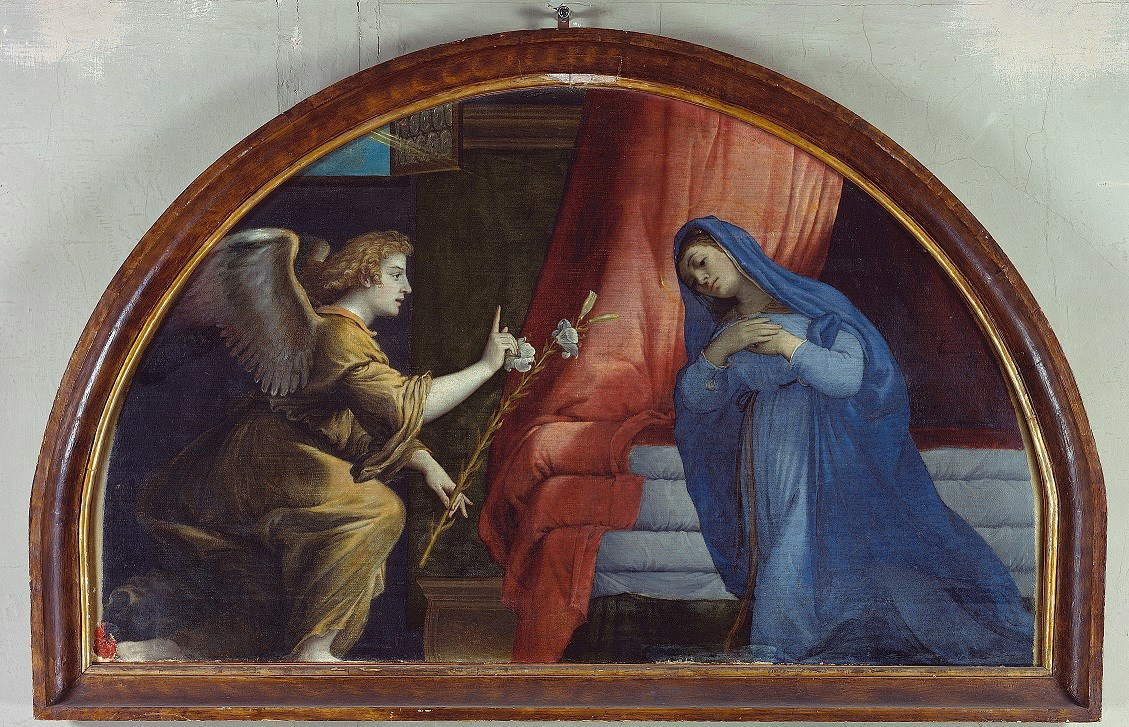 |
| Lorenzo Lotto, Annunciation (1532; oil on canvas, 103 x 132 cm; Jesi, Pinacoteca Comunale, Palazzo Pianetti) |
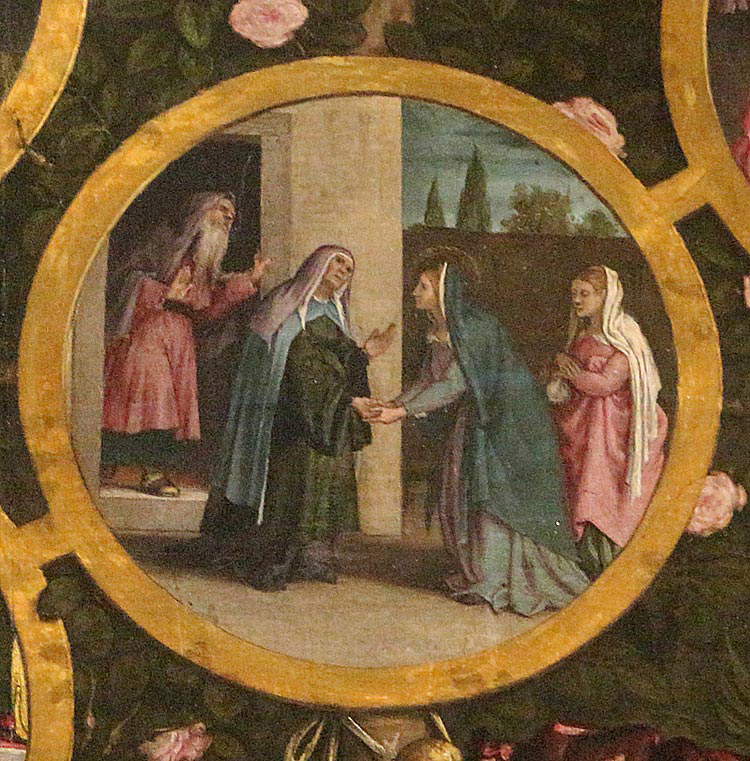 |
| Lorenzo Lotto, Madonna of the Rosary, detail (1539; oil on canvas, 384 x 264 cm; Cingoli, San Domenico) |
The Visitation left the church of San Francesco al Monte in 1866, as did all the other works belonging to the church, which was closed to worship that year, and was first placed in the church of San Floriano, after which, in 1949, it was destined for the Palazzo della Signoria. In 1971 it was moved to the headquarters of the local superintendency because of its precarious condition, so much so that between the 1970s and 1980s it underwent some restoration work, and then was transferred to the Pinacoteca Comunale, where it is still located along with all the other works that Lorenzo Lotto painted for Jesi. A town that, after Loreto, is the one in the Marche region that preserves the highest number of works by the Venetian artist.
Reference bibliography
Warning: the translation into English of the original Italian article was created using automatic tools. We undertake to review all articles, but we do not guarantee the total absence of inaccuracies in the translation due to the program. You can find the original by clicking on the ITA button. If you find any mistake,please contact us.